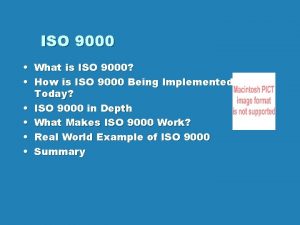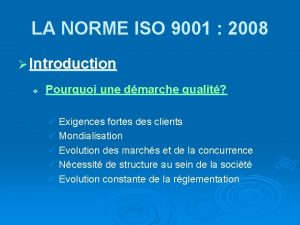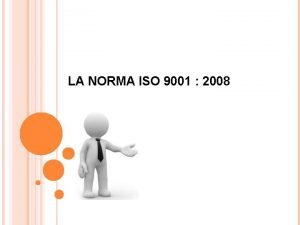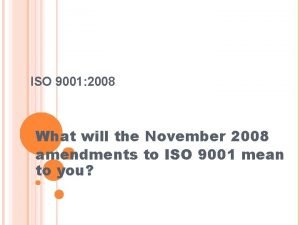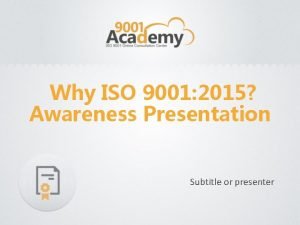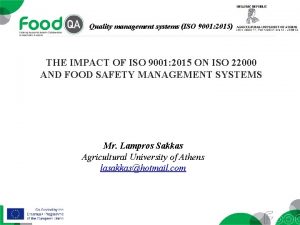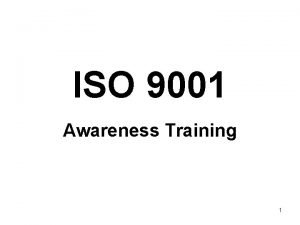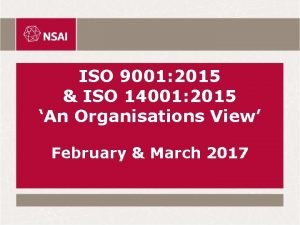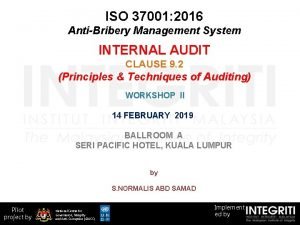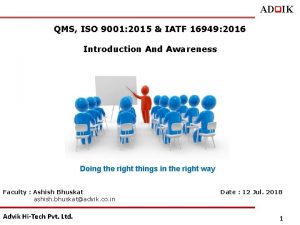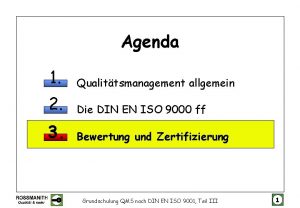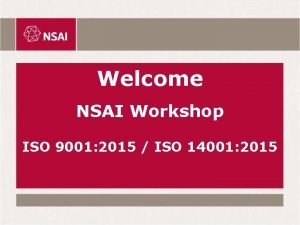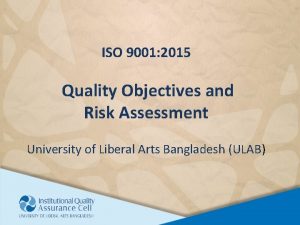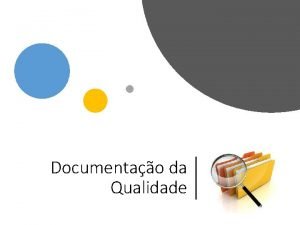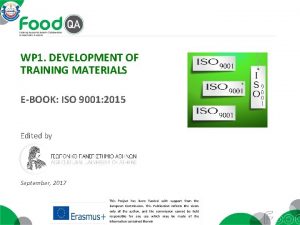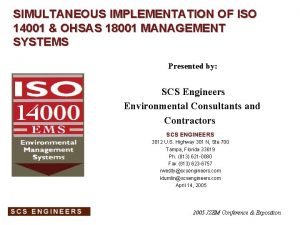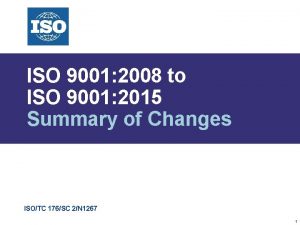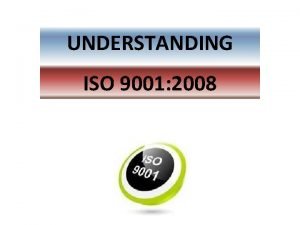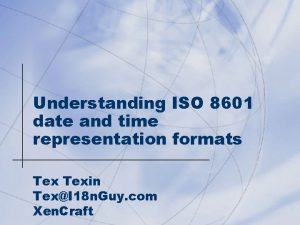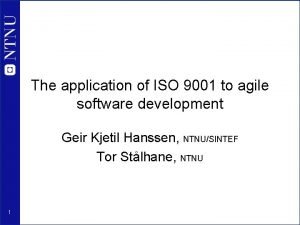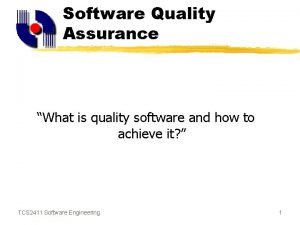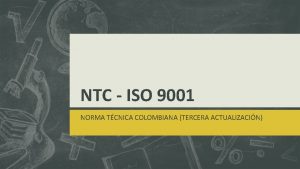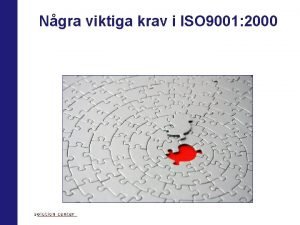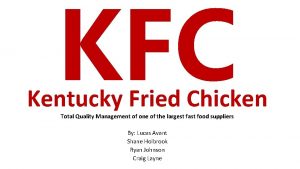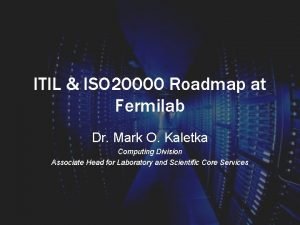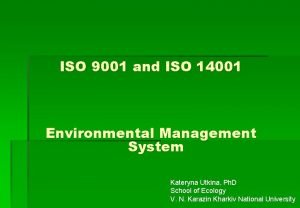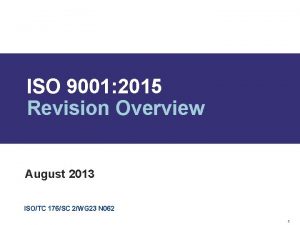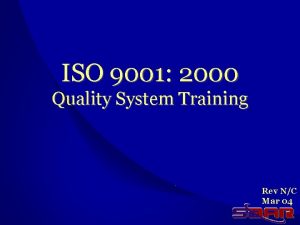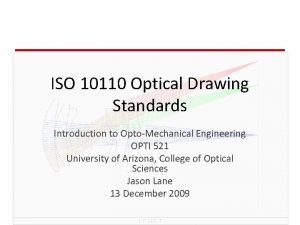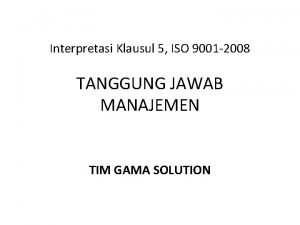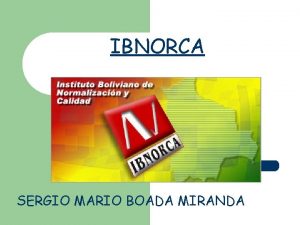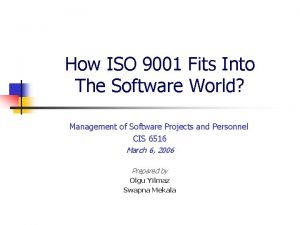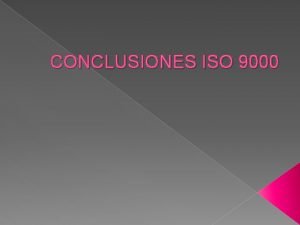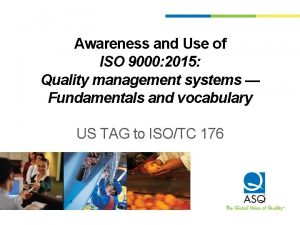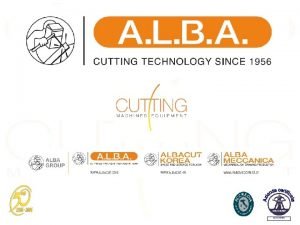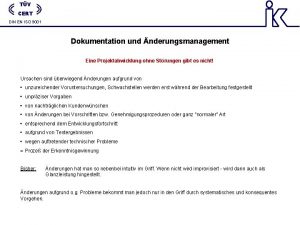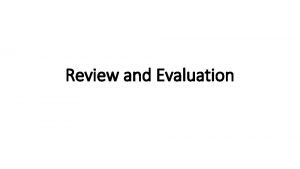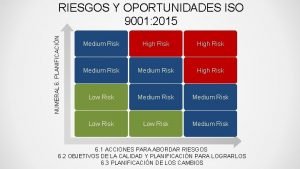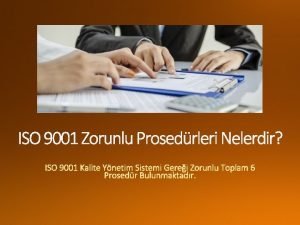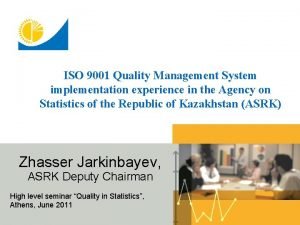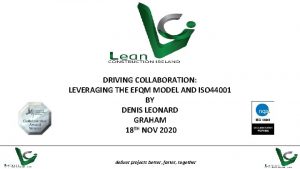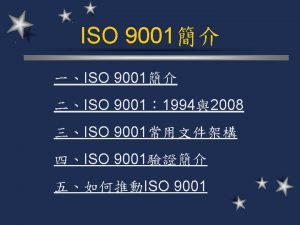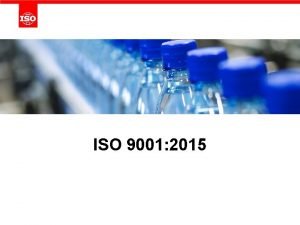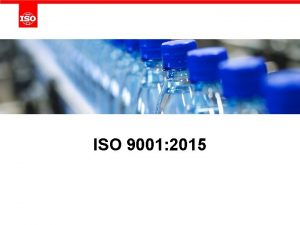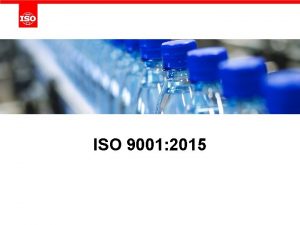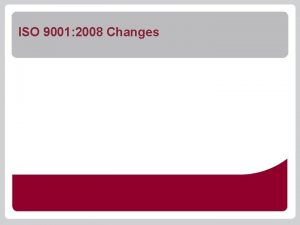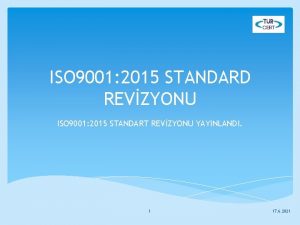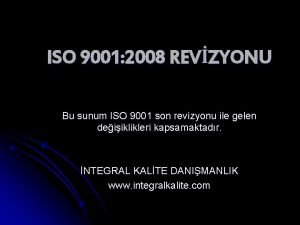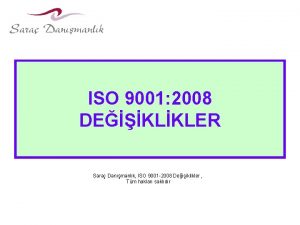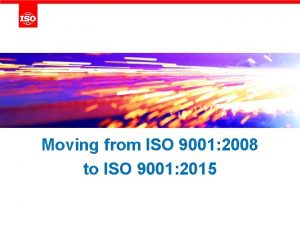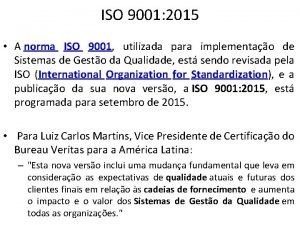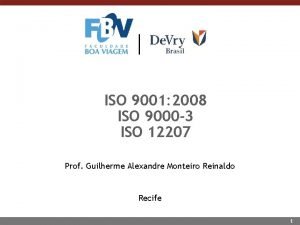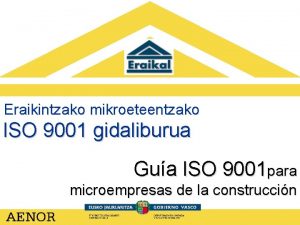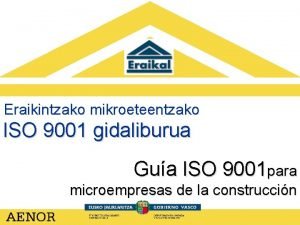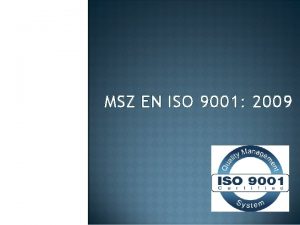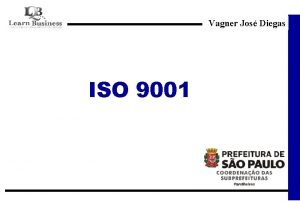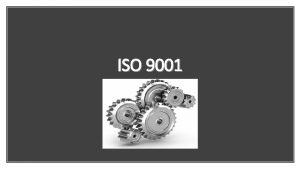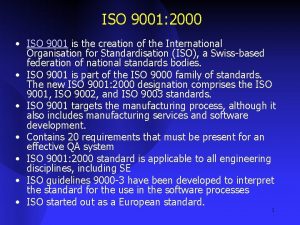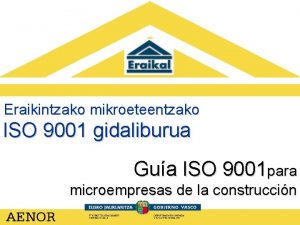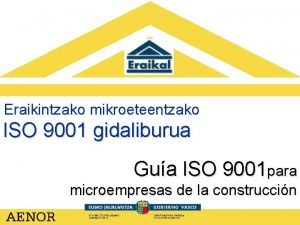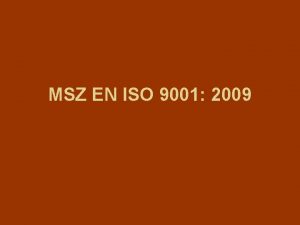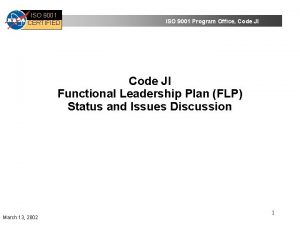ISO 9001 2008 to ISO 9001 2015 Summary












































- Slides: 44

ISO 9001: 2008 to ISO 9001: 2015 Summary of Changes ISO/TC 176/SC 2/N 1282 1

Purpose of presentation ISO/TC 176/SC 2/ N 1282 The intention of this presentation is to: § Provide a summary of notable changes from ISO 9001: 2008 to ISO 9001: 2015 2 Date: 2

Key perspectives ISO 9001 needs to change, to: § adapt to a changing world § reflect the increasingly complex environments in which organizations operate ISO/TC 176/SC 2/ N 1282 § provide a consistent foundation for the future § reflect the increasingly complex environments in which organizations operate § ensure the new standard reflects the needs of all relevant interested parties § Ensure alignment with other management system standards 3 Date: 3

ISO/TC 176/SC 2/ N 1282 Key feature changes § 10 -clause structure and core text for all Management System Standards (MSS) § More compatible with services and non-manufacturing users § Clearer understanding of the organization’s context is required “one size doesn’t fit all” § Process approach strengthened/more explicit § Concept of preventive action now addressed throughout the standard by risk identification and mitigation § The term documented information replaces the terms document and record § Control of externally provided products and services replaces purchasing/outsourcing § Increased emphasis on seeking opportunities for improvement 4 Date: 4

Beneficial changes to ISO 9001 § Enhanced leadership involvement in the management system § Risk-based thinking ISO/TC 176/SC 2/ N 1282 § Simplified language, common structure and terms § Aligning QMS policy and objectives with the strategy of the organization 5 Date: 5

ISO/TC 176/SC 2/ N 1282 Potential benefits to the user § Focus on achieving planned results § Flexibility for documented information § Improved risk control § Better process control leading to improved results § Improved customer satisfaction § Customer retention and loyalty § Improved image and reputation § Greater credibility 6 Date: 6

Key benefits of the common clause structure A new common format has been developed § All ISO management systems standards will look the same with the same structure (some deviations) ISO/TC 176/SC 2/ N 1282 § More efficient to address multiple management system requirements § Provides the option of integrating management systems § Standardized core definitions 7 Date: 7

Structure of ISO 9001: 2015 (1/3) ISO/TC 176/SC 2/ N 1282 1 Scope 2 Normative references 3 Terms and definitions 4 Context of the organization 4. 1 Understanding the organization and its context 4. 2 Understanding the needs and expectations of interested parties 4. 3 Determining the scope of the quality management system 4. 4 Quality management system and its processes 5 Leadership 5. 1 Leadership and commitment 5. 2 Policy 5. 3 Organizational roles, responsibilities and authorities 6 Planning 6. 1 Actions to address risks and opportunities 6. 2 Quality objectives and planning to achieve them 6. 3 Planning of changes 8 Date: 8

ISO/TC 176/SC 2/ N 1282 Structure of ISO 9001: 2015 (2/3) 7 Support 7. 1 Resources 7. 2 Competence 7. 3 Awareness 7. 4 Communication 7. 5 Documented information 8 Operation 8. 1 Operational planning and control 8. 2 Requirements for products and services 8. 3 Design and development of products and services 8. 4 Control of externally provided processes, products and services 8. 5 Production and service provision 8. 6 Release of products and services 8. 7 Control of nonconforming outputs 9 Date: 9

Structure of ISO 9001: 2015 (3/3) 9 Performance evaluation 9. 1 Monitoring, measurement, analysis and evaluation 9. 2 Internal audit 9. 3 Management review ISO/TC 176/SC 2/ N 1282 10 Improvement 10. 1 General 10. 2 Nonconformity and corrective action 10. 3 Continual improvement 10 Date: 10

The common structure and ISO 9001: 2015 additions 4 Context of organization 5 Leadership 6 Planning 7 Support 8 Operation 9 Performance Evaluation 4. 1 Understanding context 5. 1 Leadership and commitment 6. 1 Risks and opportunities 7. 1 Resources 8. 1 Operational planning and control 9. 1 Monitoring, measurement, analysis and evaluation 4. 2 Interested parties 5. 2 Policy 6. 2 Planning 4. 3 Scope 5. 3 Organizational roles, responsibilities and authorities 7. 2 Competence 7. 3 Awareness 10 Improvement 10. 1 General 9. 2 Internal audit 10. 2 Nonconformity and corrective action 9. 3 Management review 10. 3 Continual improvement 7. 4 Communication 4. 4 QMS ISO/TC 176/SC 2/ N 1282 7. 5 Documented information 11 Date: 11

The common structure and ISO 9001: 2015 additions 8 Operation ISO/TC 176/SC 2/ N 1282 8. 1 Operational planning and control 12 Date: 12

Plan 4 Context of organization 4. 1 Understanding context 4. 2 Interested parties 4. 3 Scope 4. 4 QMS Check Act 10 Improvement 5 Leadership 6 Planning 7 Support 8 Operation 9 Performance and Evaluation 5. 1 Leadership and commitment 6. 1 Actions to address risks and opportunities 7. 1 Resources 8. 1 Operational planning and control 9. 1 Monitoring, measurement, analysis and evaluation 5. 2 Policy 5. 3 Organizational roles, responsibilities and authorities 7. 1. 2 People 6. 2 Quality objectives and planning 7. 1. 3 Infrastructure 6. 3 Planning of changes 7. 1. 4 Environment for the operation of processes 7. 1. 5 Monitoring and measuring resources ISO/TC 176/SC 2/ N 1282 Do 7. 1. 6 Organizational knowledge See next slide 9. 1. 2 Customer satisfaction 9. 1. 3 Analysis and evaluation 10. 1 General 10. 2 Nonconformity and corrective action 10. 3 Continual improvement 9. 2 Internal audit 9. 3 Management review 7. 2 Competence 7. 3 Awareness 7. 4 Communication 7. 5 Documented information 13 Date: 13

4 Context of organization 4. 1 Understanding context Clause 4. 1 Determine what the relevant external and internal issues are for your organization, and that are relevant to its strategic direction 4. 2 Interested parties 4. 3 Scope ISO/TC 176/SC 2/ N 1282 4. 4 QMS 14 Date: 14

4 Context of organization Clause 4. 2 Identify the relevant interested parties and their relevant requirements 4. 1 Understanding context 4. 2 Interested parties 4. 3 Scope ISO/TC 176/SC 2/ N 1282 4. 4 QMS 15 Date: 15

4 Context of organization 4. 1 Understanding context 4. 2 Interested parties 4. 3 Scope ISO/TC 176/SC 2/ N 1282 4. 4 QMS Clause 4. 3 and 4. 4 The requirement for the scope is now better defined, must be documented and consider: § external and internal issues § requirements of relevant interested parties § the products and services covered (must also be stated in scope) § allowing applicability of specific requirements § justification for any case where a requirement cannot be applied (exclusion) 16 Date: 16

4 Context of organization 4. 1 Understanding context 4. 2 Interested parties 4. 3 Scope 4. 4 QMS 5 Leadership 6 Planning 7 Support 8 Operation 9 Performance and Evaluation 5. 1 Leadership and commitment 6. 1 Actions to address risks and opportunities 7. 1 Resources 8. 1 Operational planning and control 9. 1 Monitoring, measurement, analysis and evaluation 5. 2 Policy 5. 3 Organizational roles, responsibilities and authorities 7. 1. 2 People 6. 2 Objectives and planning 7. 1. 3 Infrastructure 6. 3 Planning of changes 7. 1. 4 Environment for the operation of processes ISO/TC 176/SC 2/ N 1282 7. 1. 5 Monitoring and measuring resources 7. 1. 6 Organizational knowledge See next slide 9. 1. 2 Customer satisfaction 9. 1. 3 Analysis and evaluation 10 Improvement 10. 1 General 10. 2 Nonconformity and corrective action 10. 3 Continual improvement 9. 2 Internal audit 9. 3 Management review 7. 2 Competence 7. 3 Awareness 7. 4 Communication 7. 5 Documented information 17 Date: 17

5 Leadership 5. 1 Leadership and commitment 5. 2 Policy ISO/TC 176/SC 2/ N 1282 5. 3 Organizational roles, responsibilities and authorities Clause 5. 1. 1 Leadership is required to ensure: § take accountability for the effectiveness of the quality management system § ensure the quality policy and quality objectives are compatible with the context and strategic direction of the organization § ensure the integration of the QMS requirements into the organization’s business processes § promote the use of the process approach and risk-based thinking § ensure that the QMS achieves its intended results § engage, direct and support persons to contribute to the effectiveness of the QMS § supporting relevant management roles § promotion of improvement Clause 5. 1. 2 Top management needs to ensure customer satisfaction through: § customer and applicable statutory and regulatory requirements being determined and met § risk and opportunities are being addressed § the focus on products and services meeting customers and 18 other requirements Date: 18

5 Leadership Clause 5. 2 Explicit requirement to apply the policy 5. 1 Leadership and commitment 5. 2 Policy ISO/TC 176/SC 2/ N 1282 5. 3 Organizational roles, responsibilities and authorities 19 Date: 19

5 Leadership 5. 1 Leadership and commitment 5. 2 Policy ISO/TC 176/SC 2/ N 1282 5. 3 Organizational roles, responsibilities and authorities Clause 5. 2 § Explicit requirement to apply the policy Clause 5. 3 § Explicit requirement for relevant roles to be assigned, communicated and understood § No requirement for a specific management representative and the responsibility now resides with top management to assign and manage § Requirement for defining responsibility and authority for ensuring processes are delivering their intended outputs 20 Date: 20

4 Context of organization 4. 1 Understanding context 4. 2 Interested parties 4. 3 Scope 4. 4 QMS 5 Leadership 6 Planning 7 Support 8 Operation 9 Performance and Evaluation 5. 1 Leadership and commitment 6. 1 Actions to address risks and opportunities 7. 1 Resources 8. 1 Operational planning and control 9. 1 Monitoring, measurement, analysis and evaluation 5. 2 Policy 5. 3 Organizational roles, responsibilities and authorities 7. 1. 2 People 6. 2 Quality objectives and planning 7. 1. 3 Infrastructure 6. 3 Planning of changes 7. 1. 4 Environment for the operation of processes ISO/TC 176/SC 2/ N 1282 7. 1. 5 Monitoring and measuring resources 7. 1. 6 Organizational knowledge See next slide 9. 1. 2 Customer satisfaction 9. 1. 3 Analysis and evaluation 10 Improvement 10. 1 General 10. 2 Nonconformity and corrective action 10. 3 Continual improvement 9. 2 Internal audit 9. 3 Management review 7. 2 Competence 7. 3 Awareness 7. 4 Communication 7. 5 Documented information 21 Date: 21

6 Planning 6. 1 Actions to address risks and opportunities 6. 2 Objectives and planning Clause 6. 1 § Considering the issues raised and relevant interested parties’ requirements identified (4. 1 and 4. 2), this clause requires the determination of risks and opportunities which need to be addressed, actions to be taken and evaluation of the effectiveness of these actions ISO/TC 176/SC 2/ N 1282 6. 3 Planning of changes 22 Date: 22

6 Planning Clause 6. 2 Objectives should be: 6. 1 Actions to address risks and opportunities 6. 2 Objectives and planning § established for processes relevant to the QMS § in line with customer requirements § in line with products and services conformity ISO/TC 176/SC 2/ N 1282 6. 3 Planning of changes § monitored, communicated & updated 23 Date: 23

6 Planning 6. 1 Actions to address risk and opportunity 6. 2 Objectives and planning 6. 3 Planning of changes Clause 6. 3 §Changes to the QMS should be carried out in a planned manner §The standard has evolved to enable organizations to adapt to changing environments or circumstances Note: It is important to know that change is addressed in the following clauses: § Clause 6. 3 - Planning/implementing changes to the QMS ISO/TC 176/SC 2/ N 1282 § Clause 7. 1. 6 - Organizational knowledge - for addressing changing needs and trends, with respect to knowledge § Clause 8. 1 - Controlling operational changes, planned and unintentional § Clause 8. 5. 6 - Addressing changes affecting products & services 24 Date: 24

4 Context of organization 4. 1 Understanding context 4. 2 Interested parties 4. 3 Scope 4. 4 QMS 5 Leadership 6 Planning 7 Support 8 Operation 9 Performance and Evaluation 5. 1 Leadership and commitment 6. 1 Actions to address risks and opportunities 7. 1 Resources 8. 1 Operational planning and control 9. 1 Monitoring, measurement, analysis and evaluation 5. 2 Policy 5. 3 Organizational roles, responsibilities and authorities 7. 1. 2 People 6. 2 Objectives and planning 7. 1. 3 Infrastructure 6. 3 Planning of changes 7. 1. 4 Environment for the operation of processes ISO/TC 176/SC 2/ N 1282 7. 1. 5 Monitoring and measuring resources 7. 1. 6 Organizational knowledge See next slide 9. 1. 2 Customer satisfaction 9. 1. 3 Analysis and evaluation 10 Improvement 10. 1 General 10. 2 Nonconformity and corrective action 10. 3 Continual improvement 9. 2 Internal audit 9. 3 Management review 7. 2 Competence 7. 3 Awareness 7. 4 Communication 7. 5 Documented information 25 Date: 25

7 Support 7. 1 Resources 7. 1. 2 People 7. 1. 3 Infrastructure 7. 1. 4 Environment for the operation of processes ISO/TC 176/SC 2/ N 1282 7. 1. 5 Monitoring and measuring resources 7. 1. 6 Organizational knowledge Clause 7. 1 There should be adequate resources to ensure effectiveness of the QMS. Resource considerations now include: § internal resources § external providers § people § monitoring and measuring resources § organizational knowledge required to ensure the processes provide conforming products and services § external communication 7. 2 Competence 7. 3 Awareness 7. 4 Communication . 7. 5 Documented information 26 Date: 26

7 Support 7. 1 Resources 7. 1. 2 People Clause 7. 3 and 7. 4 Relevant persons doing work under the organization’s control need to have awareness and communication (internal and external) of the QMS and benefits of improving performance 7. 1. 3 Infrastructure 7. 1. 4 Environment for the operation of processes ISO/TC 176/SC 2/ N 1282 7. 1. 5 Monitoring and measuring resources 7. 1. 6 Organizational knowledge 7. 2 Competence 7. 3 Awareness 7. 4 Communication 7. 5 Documented information 27 Date: 27

7 Support 7. 1 Resources 7. 1. 2 People 7. 1. 3 Infrastructure 7. 1. 4 Environment for operation of processes ISO/TC 176/SC 2/ N 1282 7. 1. 5 Monitoring and measuring resources 7. 1. 6 Organizational knowledge 7. 2 Competence 7. 3 Awareness Clause 7. 5. 1 Requirements that used to be required for a quality manual have been enhanced and made more flexible to allow for the use of documented information needed for the quality management system Clause 7. 5. 2 Enhanced requirement for the creation and updating of documented information, e. g. description, format & suitability Clause 7. 5. 3 Control of documented information – now explicitly includes confidentiality, integrity and access 7. 4 Communication 7. 5 Documented information 28 Date: 28

4 Context of organization 4. 1 Understanding context 4. 2 Interested parties 4. 3 Scope 4. 4 QMS 5 Leadership 6 Planning 7 Support 8 Operation 9 Performance and Evaluation 5. 1 Leadership and commitment 6. 1 Actions to address risks and opportunities 7. 1 Resources 8. 1 Operational planning and control 9. 1 Monitoring, measurement, analysis and evaluation 5. 2 Policy 5. 3 Organizational roles, responsibilities and authorities 7. 1. 2 People 6. 2 Objectives and planning 7. 1. 3 Infrastructure 6. 3 Planning of changes 7. 1. 4 Environment for operation of processes ISO/TC 176/SC 2/ N 1282 7. 1. 5 Monitoring and measuring resources 7. 1. 6 Organizational knowledge See next slide 9. 1. 2 Customer satisfaction 9. 1. 3 Analysis and evaluation 10 Improvement 10. 1 General 10. 2 Nonconformity and corrective action 10. 3 Continual improvement 9. 2 Internal audit 9. 3 Management review 7. 2 Competence 7. 3 Awareness 7. 4 Communication 7. 5 Documented information 29 Date: 29

ISO/TC 176/SC 2/ N 1282 4 Context of organization 5 Leadership 6 Planning 7 Support 8 Operation 9 Performance and Evaluation 8. 1 Operational planning and control 8. 3 Design and development of products and services 8. 4 Control of externally provided processes, products and services 8. 5 Production and service provision 8. 2 Requirements for products and services 8. 3. 1 General 8. 4. 1 General 8. 5. 1 Control of production and service provision 8. 2. 1 Customer communication 8. 3. 2 Design and development planning 8. 4. 2 Type and extent of control 8. 5. 2 Identification and traceability 8. 2. 2 Determination of requirements related to products and services 8. 3. 3 Design and development Inputs 8. 4. 3 Information for external providers 8. 5. 3 Property belonging to customers or external providers 8. 2. 3 Review of requirements related to products and services 8. 3. 4 Design and development controls 8. 2. 4 Changes to requirements for products and services 8. 3. 5 Design and development outputs 8. 3. 6 Design and development changes 10 Improvement 8. 6 Release of products and services 8. 7 Control of nonconforming process outputs 8. 5. 4 Preservation 8. 5. 5 Post-delivery activities 8. 5. 6 Control of changes 30 Date: 30

8 Operation Clause 8. 1. b § explicit requirement for establishing criteria for processes 8. 1 Operational planning and control 8. 2 Requirements for products and services 8. 2. 1 Customer communication ISO/TC 176/SC 2/ N 1282 8. 2. 2 Determination of requirements related to products and services 8. 2. 3 Review of requirements related to products and services Clause 8. 2. 1 § explicit considerations are now linked to: customer communications; customer property, and contingency actions Clause 8. 2. 2 § Determination of requirements; this requires a process and is explicit with regard to substantiating claims for products and services being offered 8. 2. 4 Changes to requirements for products and services 31 Date: 31

8 Operation Clause 8. 3 This section on design and development of products and services has substantively changed and simplified: 8. 3 Design and development of products and services 8. 3. 1 General 8. 3. 2 Design and development planning 8. 3. 3 Design and development inputs ISO/TC 176/SC 2/ N 1282 8. 3. 4 Design and development controls 8. 3. 5 Design and development outputs 8. 3. 6 Design and development changes Clause 8. 3. 2 § Design and development has been restructured to allow for a more process orientated approach § Involvement of customers and users as part of design planning to be considered Clause 8. 3. 3 § Design and development inputs – explicit requirements for internal and external resource needs, potential consequences of failure, level of control expected by customers Clause 8. 3. 4 § Design and development controls – new clause combining Reviews, Verification & Validation 32 Date: 32

8 Operation 8. 4 Control of externally provided processes products and services Clause 8. 4 § The terms which previously referred to purchasing and ‘outsourcing’ is now ‘Control of externally provided processes, products and services’ Clause 8. 4. 1 General 8. 4. 2 Type and extent of control 8. 4. 3 Information for external providers § Conditions are applied when controls are required for externally provided processes, products and service § Terminology has changed from ‘supplier’ to ‘external provider’ ISO/TC 176/SC 2/ N 1282 Clause 8. 4. 2 § Type and extent of control of external provision previous notes in 4. 1 (ISO 9001: 2008) now turned into requirements Clause 8. 4. 3 § Information for external providers are now more detailed and explicit 33 Date: 33

8 Operation Clause 8. 5. 1 This clause specifically considers: 8. 5 Production and service provision 8. 5. 1 Control of production and service provision 8. 5. 2 Identification and traceability 8. 5. 3 Property belonging to customers or external providers ISO/TC 176/SC 2/ N 1282 8. 5. 4 Preservation § monitoring and measurement activities will ensure the control of processes and output (clauses 8. 2. 3 and 8. 2. 4 of ISO 9001: 2008 have been moved to 8. 5. 1) § acceptance criteria for products and services are met § the use, and control of suitable infrastructure and process environment § suitable monitoring and measuring resources § Requires competent persons 8. 5. 5 Post-delivery activities 8. 5. 6 Control of changes 34 Date: 34

8 Operation 8. 5 Production and service provision 8. 5. 1 Control of production and service provision 8. 5. 2 Identification and traceability 8. 5. 3 Property belonging to customers or external providers ISO/TC 176/SC 2/ N 1282 8. 5. 4 Preservation 8. 5. 5 Post-delivery activities 8. 5. 6 Control of changes Clause 8. 5. 2 § The identification and traceability now focus on ‘outputs’ rather than on ‘product’ (includes intermediate products and services) rather than on ‘product’ Clause 8. 5. 3 § Customer property has been expanded to include external providers’ property Clause 8. 5. 4 § Preservation of product has been changed to preservation of the output Clause 8. 5. 5 § Post-delivery activities is a new clause Clause 8. 5. 6 § A new requirement for the control of changes is addressed in the slide introducing the concept of change 35 Date: 35

8 Operation Clause 8. 6 § The release of products and services is now part of the operational requirements 8. 6 Release of products and services 8. 7 Control of nonconforming outputs Clause 8. 7 § The control of nonconforming output is more explicit; it now considers the options to apply correction and corrective action ISO/TC 176/SC 2/ N 1282 § Nonconforming product changed to nonconforming output 36 Date: 36

4 Context of organization 4. 1 Understanding context 4. 2 Interested parties 4. 3 Scope 4. 4 QMS 5 Leadership 6 Planning 7 Support 8 Operation 9 Performance evaluation 5. 1 Leadership and commitment 6. 1 Actions to address risks and opportunities 7. 1 Resources 8. 1 Operational planning and control 9. 1 Monitoring, measurement, analysis and evaluation 5. 2 Policy 5. 3 Organizational roles, responsibilities and authorities 7. 1. 2 People 6. 2 Quality objectives and planning 7. 1. 3 Infrastructure 6. 3 Planning of changes 7. 1. 4 Environment for the operation of processes ISO/TC 176/SC 2/ N 1282 7. 1. 5 Monitoring and measuring resources 7. 1. 6 Organizational knowledge See next slide 9. 1. 2 Customer satisfaction 9. 1. 3 Analysis and evaluation 10 Improvement 10. 1 General 10. 2 Nonconformity and corrective action 10. 3 Continual improvement 9. 2 Internal audit 9. 3 Management review 7. 2 Competence 7. 3 Awareness 7. 4 Communication 7. 5 Documented information 37 Date: 37

9 Performance evaluation 9. 1 Monitoring, measurement, analysis and evaluation 9. 1. 1 General 9. 1. 2 Customer satisfaction ISO/TC 176/SC 2/ N 1282 9. 1. 3 Analysis and evaluation 9. 2 Internal audit Clause 9. 1. 1 § In 8. 1 ISO 9001: 2008 (clause 8. 1) there was a requirement for planning. This is replaced with identifying what needs monitoring and measuring, and the methods to be used Clause 9. 1. 3 § There are specific requirements for analysis and evaluation when using results as inputs to management review § Effective implementation of planning and actions to address risks and opportunities are new requirements in this clause 9. 3 Management review 38 Date: 38

9 Performance Evaluation 9. 1 Monitoring, measurement, analysis and evaluation 9. 1. 2 Customer satisfaction 9. 1. 3 Analysis and evaluation ISO/TC 176/SC 2/ N 1282 9. 2 Internal audit 9. 3 Management review 9. 3. 1 General 9. 3. 2 Management review input 9. 3. 3 Management review output Clause 9. 2 § Internal audit program now has explicit considerations for: quality objectives, customer feedback and changes impacting the organization; management responsibility for action is now implicit whereas previously this was explicit § An auditor is now required to be impartial versus in the previous version they could not audit their own work Clause 9. 3 § There are now additional requirements for management review. These include: § changes in external and internal issues (such as strategic direction) § performance concerning external providers § adequacy of resources for effective QMS and effectiveness of actions taken addressing risks & opportunities Clause 9. 3. 1 § Management reviews should be aligned to the strategic direction of the organization Clause 9. 3. 3 § Management review outputs have been enhanced to include many of the new areas of focus 39 Date: 39

4 Context of organization 4. 1 Understanding context 4. 2 Interested parties 4. 3 Scope 4. 4 QMS 5 Leadership 6 Planning 7 Support 8 Operation 9 Performance Evaluation 5. 1 Leadership and commitment 6. 1 Actions to address risks and opportunities 7. 1 Resources 8. 1 Operational planning and control 9. 1 Monitoring, measurement, analysis and evaluation See next slide 9. 1. 2 Customer satisfaction 10. 2 Nonconformity and corrective action 9. 1. 3 Analysis and evaluation 10. 3 Continual improvement 5. 2 Policy 5. 3 Organizational roles, responsibilities and authorities 7. 1. 2 People 6. 2 Objectives and planning 7. 1. 3 Infrastructure 6. 3 Planning of changes 7. 1. 4 Environment for the operation of processes ISO/TC 176/SC 2/ N 1282 7. 1. 5 Monitoring and measuring resources 7. 1. 6 Organizational knowledge 10 Improvement 10. 1 General 9. 2 Internal audit 9. 3 Management review 7. 2 Competence 7. 3 Awareness 7. 4 Communication 7. 5 Documented information 40 Date: 40

10 Improvement 10. 1 General 10. 2 Nonconformity and corrective action ISO/TC 176/SC 2/ N 1282 10. 3 Continual improvement Clause 10. 1 § This clause is new, it addresses more comprehensive opportunities for improvement; not only continual improvement § Addresses improvement of products and services and future needs and expectations § Emphasis is now on improving processes to prevent nonconformities and improving products and services Clause 10. 2 § The nonconformity referred to in this clause concerns the entire QMS and not specifically the products or services which are addressed under clause 8. 7 Clause 10. 2. 1 § New emphasis is placed on nonconformity and corrective action § Consequences are now included thus actions taken now recognize the potential occurrence of a similar nonconformity elsewhere § Risks and opportunities now need to be updated when required following a nonconformity Clause 10. 2. 2 § Documented information is now required on the nature of the nonconformity and subsequent actions taken Clause 10. 3 § Opportunities shall be addressed as part of continual improvement 41 Date: 41

Summary § Determining the organizational context enables a more effective implementation of the quality management system § Greater emphasis on processes being managed to achieve planned results § Alignment with strategic direction § Integration of the QMS into organization’s business processes ISO/TC 176/SC 2/ N 1282 § Determining risks and opportunities increase the effectiveness of the organization’s QMS § Change management has been expanded to add emphasis that the QMS should be carried out in a planned manner § The concept of organizational knowledge introduced to ensure the organization acquires and maintains the necessary knowledge § Communication expanded to include external 42 Date: 42

ISO 9001: 2015 Certification Transition Timeline 2015 2016 2017 2018 ISO/TC 176/SC 2/ N 1282 September 2015 Published International Standard September 2015 start of 3 years transition period to September 2018 Certifications to ISO 9001: 2008 will no longer be valid after September 2018 43 Date: 43

More information Further information is available at ISO/TC 176/SC 2/ N 1282 www. iso. org/tc 176/sc 02/public 44 Date: 44
 Used il acl 9000
Used il acl 9000 Norme iso 9001 2008
Norme iso 9001 2008 Norma iso 9001: 2008
Norma iso 9001: 2008 Iso 9001:2008 certification in mumbai
Iso 9001:2008 certification in mumbai Iso 9001:2015 presentation
Iso 9001:2015 presentation Major changes in iso 9001 for 2015
Major changes in iso 9001 for 2015 Iso 9001:2015 management review meeting presentation ppt
Iso 9001:2015 management review meeting presentation ppt Objective of quality
Objective of quality Iso 37001 audit checklist pdf
Iso 37001 audit checklist pdf Process interaction matrix
Process interaction matrix Management review iso 9001 version 2015 muster
Management review iso 9001 version 2015 muster Nsai iso 9001
Nsai iso 9001 ıso 9001:2015 kalite el kitabı örnekleri
ıso 9001:2015 kalite el kitabı örnekleri Iso 9001:2015 risk assessment example
Iso 9001:2015 risk assessment example Controle de informação documentada iso 9001
Controle de informação documentada iso 9001 Ebook iso 9001 2015
Ebook iso 9001 2015 Iso 9001 iso 14001 ohsas 18001 comparison
Iso 9001 iso 14001 ohsas 18001 comparison Iso 9001 summary
Iso 9001 summary 2008 2008
2008 2008 Iso 9001 history
Iso 9001 history Time representation format
Time representation format Agile iso 9001
Agile iso 9001 Iso 9001 software quality assurance
Iso 9001 software quality assurance Norma tecnica colombiana iso 9001
Norma tecnica colombiana iso 9001 Iso 9001:2000
Iso 9001:2000 Kfc iso 9001
Kfc iso 9001 What is iso 20000 how does it relate to itil
What is iso 20000 how does it relate to itil Ems iso 9001
Ems iso 9001 Iso 9001 introduction
Iso 9001 introduction Iso 9001 2000 training
Iso 9001 2000 training Tabular method example
Tabular method example Klausul 5 iso 9001
Klausul 5 iso 9001 Ibnorca iso 9001
Ibnorca iso 9001 Iso 9000 vs 9001
Iso 9000 vs 9001 Conclusion de las normas iso 9000
Conclusion de las normas iso 9000 Synonym for extremely important
Synonym for extremely important Uni en iso 9001 2000
Uni en iso 9001 2000 änderungsmanagement iso 9001
änderungsmanagement iso 9001 Iso12207
Iso12207 Qmhandbuch überlingen
Qmhandbuch überlingen Iso 9001 6
Iso 9001 6 Iso 9001 prosedürleri
Iso 9001 prosedürleri Iso 9001:2012
Iso 9001:2012 Exemple fiche processus ressources humaines
Exemple fiche processus ressources humaines Efqm
Efqm
